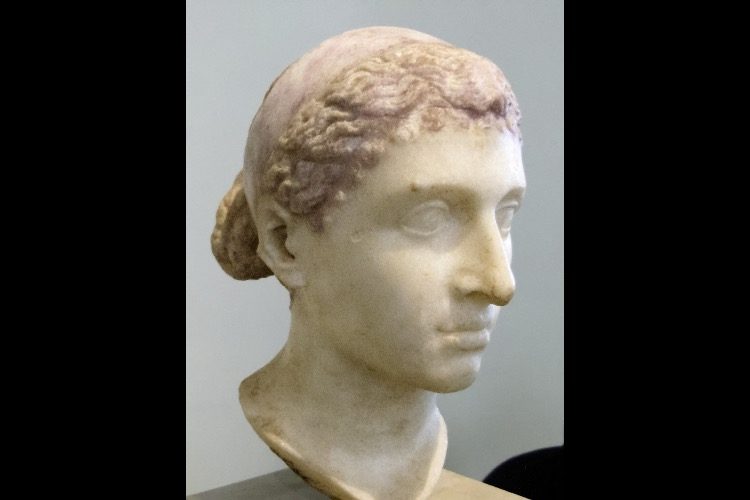
It’s ironic that in this time of hand-wringing over “cultural appropriation,” where a white person may be criticized for wearing cornrow braids or portraying a non-white TV character, we hear indignant insistence that Egypt’s most famous Greek queen, Cleopatra, was black. Of course, given that there’s also a musical (Hamilton) portraying the Founding Fathers as non-white and claims that even some British kings were black, this fancy is not surprising.
But how did the idea originate? Is it merely a function of some people’s misconception that the ancient Egyptians were black? Well, one writer theorizes that there could be another source for the idea: a late 19th-century erotic French novel.
At American Thinker, George M. Hollenback introduces the story. “In the trailer for the disastrous Netflix documentary Queen Cleopatra, classics professor Shelley Haley states, ‘I remember my grandmother saying to me, ‘I don’t care what they teach you in school. Cleopatra was black,’” he relates. “The documentary goes on to depict the queen as black, or at least biracial.”
Of course, since entertainment is about attracting eyeballs, not historical accuracy — and since Netflix’s black Cleopatra drew great attention — this is not surprising. Yet the actual story of the ill-fated queen is far more interesting than any identity-politics tale.
Cleopatra was the last in the line of a foreign dynasty that ruled Egypt for more than 350 years (305 B.C. to 79 A.D.) and whose origins lay in the conquests of famed Macedonian Alexander the Great.
After Alexander died in 323 B.C., his generals divided up his great empire. Egypt became the domain of a man named Ptolemy, who took the title Ptolemy I Soter (“Savior.” Yes, people back then marketed themselves, too).
Now, as is common in the history of royals, the Ptolemies strove to keep their bloodlines pure, even sometimes resorting to intermarriage to this end. Fast forward three centuries and we come to Cleopatra, who became “co-regent” in 51 B.C. and adopted the name Cleopatra VII Thea Philopator (“father-loving goddess”). To further grasp how important maintaining dynastic integrity was to the Ptolemies, note that as “VII” indicates, the famed queen was not the first Cleopatra; in fact, Alexander the Great had a sister by that name.
What gives revisionists wiggle room (in their minds) to claim Cleopatra was black is that little is known about her mother. “Had Cleopatra’s mother been a Nubian or even a native Egyptian, however, such a fact probably would have been seized upon and used as a cudgel against the legitimacy of her rule by the polemicists and detractors of the day,” Hollenback points out. “It would have been the kind of thing that chroniclers of the time surely would have noted. More than likely, Cleopatra’s mother was probably just another Greco-Macedonian Alexandrian.”
Even if the queen’s mother had been an Egyptian, though, a fairly fanciful notion itself, it’s even more fanciful thinking that the woman would’ve been black. For modern DNA testing of mummies has determined that “the ancient Egyptians were most closely related to the peoples of the Near East, particularly from the Levant,” reported The Archaeologist blog in 2022. Even modern Egyptians share only eight percent “of their genome with central Africans,” the site later adds, and this is “far more than ancient ones, according to the study [in question].”
(Note, too, that modern Egypt is Arab, and Arabs are also classified as Caucasian.)
Now we come to the novel that, Hollenback theorizes, might have sparked the novel notion of Cleopatra’s blackness. In 1896, an erotic five-volume work “by Pierre Louÿs, Aphrodite: Mœurs Antiques, created quite a stir in French literary circles,” he writes. “The subject matter was the life of courtesans in ancient Alexandria when Cleopatra was a young girl…. Chapter seven of book three gives a description of the young Cleopatra.”
For sleuths aiming to do their own research, Hollenback mentions that, oddly, many successive editions of the book have omitted the Cleopatra chapter. So you must find a version that reflects the original work. And if you do, here’s the passage you’ll read about the queen, courtesy of Hollenback:
Queen Berenice had a younger sister called Cleopatra. Many Egyptian princesses had borne this name, but this girl became in later years the renowned Cleopatra who destroyed her kingdom and killed herself on the corpse of her dead realm, so to say. She was at this time about twelve years old, and no one could yet tell what her beauty would be. Tall and slender, she seemed not to belong to a family in which all the females were plump. She was ripening like some defectively grafted bastard fruit of obscure and outlandish origin. Some of her lineaments were hard and bold, like those seen in Macedonia; other traits seemed a heritage from the depths of Nubia, where womankind is tender and swarthy. Her mother had been a woman of inferior race and dubious pedigree. It was surprising to see Cleopatra’s almost negroid lips under a delicately formed aquiline nose. Her young breasts were round, small, set wide apart, and the swelling aureolae which crowned them marked her a daughter of the Nile (p. 177).
Having been read by many educated people at the time, Aphrodite certainly might’ve had an impact. Furthermore, because of author Louÿs’s reputation as a man “of great erudition, many readers may have assumed the above description to be based on some kind of actual historical research,” Hollenback writes — “when in fact it was nothing more than exotic fiction.”
Regardless of the book’s influence, the reality is that we don’t have to scratch our heads wondering about Cleopatra’s appearance, as it is represented in many statues and coin images from her time (videos below).
As these images make clear, Cleopatra absolutely had Caucasian features. As the second video, especially, shows, she looked, shocker of shockers, Greek.
If even this isn’t enough to convince the Caucaphobic revisionists that Cleopatra was white, however, then, okay, one more fact surely will. Ready?
The queen had slaves!


